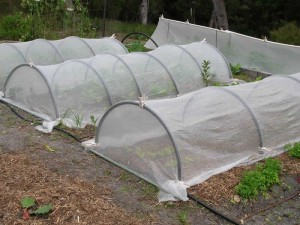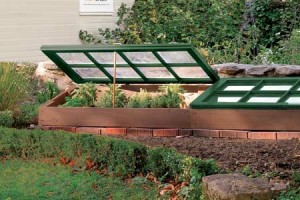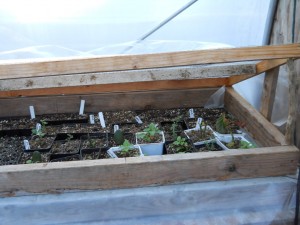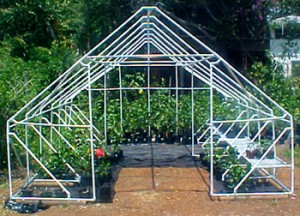With skyrocketing prices at the grocery store and an unstable economy, it’s no surprise people are turning back to the ways of their grandparents and great-grandparents. Self sufficiency is needed now more than ever, and a greenhouse can provide fresh, healthy food for families virtually year round. In the case of a natural disaster, pandemic, or even a government collapse, going to the grocery store may not be an option. Being prepared with a convenient source of healthy food can mean the difference between life and death, and a greenhouse can make all the difference when it matters most.
A greenhouse works by greatly increasing the growing season for a variety of vegetables. It does this by controlling temperatures, light, and even humidity. Although greenhouses increase the amount of time a vegetable can grow, vegetables still need to be grown around the time of their proper seasons in traditional greenhouses. Rotating what vegetables are growing based on their seasons means a family can have a variety of food year round. For example, during the winter months broccoli and cauliflower grow great, while summer can provide cucumbers, lettuce, and eggplants. The variety of vegetables changes with the seasons so families will always have healthy options available.
Before picking out a greenhouse, it’s important to look at both the pros and cons of the various structures. Listed below are different types of structures with their benefits and drawbacks. Determining which one best fits a given situation.
A hoop house is a relatively basic form of a greenhouse. Using limited materials, this type of greenhouse has a wooden framework placed on the ground in a rectangular shape and arched “hoops” starting at one side and going to the other. A variety of covers can be used, such as a shade fabric or polyethylene film. Although it looks like a quonset hut in design, it is much more basic. The benefits to a hoop house are the low cost, relatively easy set up and the ability to move them as needed.
Since the hoop house can only minimally control light and temperature, it is used mostly for crops that are hardier and less susceptible to temperature fluctuations. Vegetables such as broccoli or cabbage grow well in a hoop house, but for more delicate crops, this type of structure wouldn’t be recommended.
A cold frame greenhouse is much like a hoop house and offers the same benefits, with the exception of being mobile. The ground framework is put partially into the ground, rendering it difficult to move. The hoops that hold up the covering are shorter than in a hoop house, and occasionally you will see one with a flat roof placed on the top.
Cold frames are also good for growing hardy crops starting early in the spring. Cold frames can also provide necessary cold treatments for anyone wishing to grow bulb crops, such as garlic. Bulb crops need to maintain a temperature between 35-48° F for about 13 weeks. Cold frames have no source of heating or cooling in them making a cold frame a good option for these two crops.
A hot bed is similar to a cold frame except there is some type of heating source, which helps to control the temperature inside. The heat can come from a number of different sources such as: incandescent light bulbs, electrical heating units, boiler steam, or even composting manure. Hot beds are a great way to start seedlings early in the spring.
One drawback to a hot bed is the soil must be checked often to make sure it isn’t drying out too quickly. If this happens, it can be hard for the seeds to germinate or for young seedlings to survive. The hot bed is typically used for this purpose only, and as the plants begin to grow they are then placed in a garden or other type of greenhouse.
A-frame greenhouses are named because of their shape, which is the form of an ‘A’ in design. They are made of a simple construction with posts and rafters that are embedded. This design allows for more space near the sidewalls and also provides excellent air circulation. It is easy to build and more permanent than other greenhouses. The A-frame is a sturdy design and works well in windy climates.
Drawbacks to the A-frame are that it takes much more building material for the supporting trusses, and therefore ends up costing more upfront.
A quonset greenhouse has an arched roof which allows stress to be effectively transferred to the base. The quonset has the advantage of being cheaper to build than many other greenhouses.
Some quonsets are built with a lower ceiling, meaning users need to be short or may need to bend over. For the taller quonsets, the covers seem to rip more readily, making replacement costs something to consider.
Gothic
The gothic is also referred to as a gothic arch. It closely resembles a quonset except there is a point at the top. This point works well for people in snowy climates as the snow will just slide off and not accumulate which could cause the structure to weaken. The gothic is typically taller than a quonset, allowing for more headroom.
The gothic is much more difficult and time consuming to construct when compared to other greenhouses, but may be worth the time and effort in colder climates.
Gutter Connect and Free-Span
These types of greenhouses are used for growing things in bulk. The advantages are that it’s like having several greenhouses connected without walls separating them. There is a large, open area with plenty of room to grow many things.
Disadvantages to this are the expensive cost. These types of greenhouses are popular with people with lots of land or even businesses and aren’t really cost effective for a single family.
Find out more about food independence on Backyard Liberty.
SOURCE : survivopedia.com






